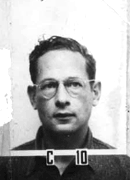
Robert Serber’s photo badge for Los Alamos National Laboratory.
Beginnings
On March 14, 1909, Dr. Robert Serber, an American physicist, was born. Dr. Serber was the protege of Dr. Robert Oppenheimer, widely known for his work as a director for the Los Alamos Project. Serber’s job entitled explaining the basic principles and goals of the Manhattan Project to incoming staff.
Education
In 1930, Serber earned his B.S. in Engineering Physics from Lehigh University and his Ph.D. from University of Wisconsin, Madison with John Van Vleck in 1934. After earning his doctorate, he began his postdoctoral work at University of California, Berkeley with Oppenheimer where the two became friends and also his mentor.
Los Alamos
Shortly after, Serber was recruited by Oppenheimer for the Manhattan Project in 1941. As head of the laboratory, Oppenheimer decided to not separate the information among the different departments in order to give the departments a sense of unity and a common goal. This allowed them to work more efficiently and sparked a sense of urgency towards completion of the project. This decision also increased the partnerships and relationships between departments as it gave the scientists a clearer idea of the common goal they shared. In order to keep the departments on the same page, it fell on Serber to keep them up to date hence the creation of The Los Alamos Primer, which was based off of the conclusions from a conference held at the University of California, Berkeley by Oppenheimer. It has been declassified and is now available to the public.
Along with Serber’s amazing ability to illustrate complicated concepts, he had a knack for clever names. He was responsible for the witty code-names for all three bomb designs — the “Little Boy” was the uranium gun, the “Thin Man” was the plutonium gun, and the “Fat Man” was the plutonium implosion. The code-names given were based on their design shapes. The “Little Boy” was named in contrast to the “Thin Man” which was a very long device and also inspired by the Dashiell Hammett detective novel The Thin Man. The “Fat Man” bomb was round and fat and inspired by a character in The Maltese Falcon.
Postwar
Serber’s hard work and efforts did not go unnoticed. In 1972, Serber was awarded the J. Robert Oppenheimer Memorial Prize for his work in theoretical physics and the Manhattan Project. The award included a medal, certificate and a $1000 reward. Unfortunately, Robert Serber died on June 1, 1997 due to complications after surgery for brain cancer. Serber’s legacy will be appreciated and remembered by many.
SOURCES
- “Robert Serber (1909 – 1997).” Robert Serber | Biography, 2015, www.atomicarchive.com/Bios/Serber.shtml.
- “Robert Serber.” Atomic Heritage Foundation, 14 Mar. 1909, www.atomicheritage.org/profile/robert-serber.
- “Robert Serber.” Wikipedia, Wikimedia Foundation, 23 Dec. 2017, en.wikipedia.org/wiki/Robert_Serber.
- Freeman, Karen. “Robert Serber, 88, Physicist Who Aided Birth of A-Bomb.” The New York Times, The New York Times, 1 June 1997, www.nytimes.com/1997/06/02/us/robert-serber-88-physicist-who-aided-birth-of-a-bomb.html?scp=1&sq=Robert%2BSerber&st=cse.
Written by Sabrina Au.

